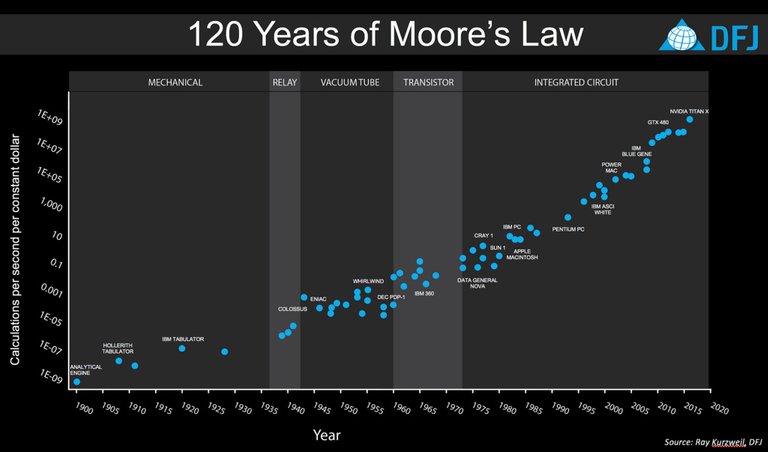The question is: “How far will technology go”? It’s been 10 years since the iPhone was first introduced, and it was revolutionary considering that this was the first smart phone available to the main stream market. Ever since then the capabilities of the iPhone, or any piece of technology of this matter has grown exponentially. For example; the first-generation iPhone had 128 MB of RAM, now the iPhone X has 3 GB of RAM. That’s over a 2300% increase in memory!
This phenomenon or observation is stated in Moore’s Law. Moore’s Law is the observation that the number of transistors in a dense integrated circuit doubles approximately every two years. This occurrence is incredible, and because of this we can expand our technology into something new and reach into different fields of studies. Computer science has already had amazing implementations into the world of business, art, and medicine.

If we observe the world around us and compare the societies we live in today versus the pre-technology eras; individuals of the past would consider us Gods amongst men with the power technology grants us. We hold the power to instantly communicate with another individual across the world, access infinite information on internet and visually document everything we see and hear with the push of a button. It has only been 10 years since the first mainstream smartphone and 81 years since the first programmable computer. It hasn’t been a full century yet and we we’re able to send a man to the moon and back.
If we analyze the progress we’ve made so far, it’s almost hard to believe what we could accomplish 300 years from now. The potential for technology growth is infinite, but achieving it within a realistic time-frame is the main concern. Some have argued that Moore’s Law is slowing down and this could potentially be due to us reaching physical limitations; however, it is hard to argue whether Moore’s Law is really slowing down due to the lack of data we have and how vague Moore’s Law is.

Moore’s Law aside, from where we came from to where we are now we have implementations of automation and computer science practically everywhere. We already have technology that can help a man with no legs walk, or help a color-blinded individual see color. We have electric vehicles that can out-perform regular gasoline powered vehicles, and we have computers that can perform billions of arithmetic operations in a very short time frame.
Where do we stop? It’s safe to assume that the biggest limitation to technological growth will always be the actual physical limitations. Yes; we can fit billions of transistors on a microchip today but if the size of the microchip doesn’t increase we will eventually fill every bit of real estate on that chip. We cannot reduce the size of our technology beyond the atomic level, at least not yet. We could write efficient algorithms that can solve processes faster but for as long as we know that we can't physically exceed a certain size our technology will hold a limitation.
Quite frankly with our current technology and how much we can grow we still have plenty of room for improvement. There may be a limit, but that limit won’t pose too much of a problem just yet. How far will technology go? As far as we decide to take it; technology isn’t just an invention, it’s another world. It’s a world with unlimited potential and from what we were able to accomplish in less than a century, the centuries ahead of us hold very promising innovations.
TL;DR: Moore’s Law is the observation that the number of transistors in a dense integrated circuit doubles approximately every two years. This phenomenon can be seen when comparing the first-generation iPhone with the iPhone we have now. From the first-generation iPhone to the current generation iPhone we have seen a 2300% increase in memory capacity. For those who aren’t apple users this law applies to all types of computers.
The biggest limitation to technological growth is not the software. Day by day we find better and more efficient ways of writing code to solve complex algorithms. The limitation behind technological growth lies on the fact that we cannot shrink the size of our technology beyond the atomic level. We are physically limited by the laws of physics, however, we still have plenty of room for growth. Technology will go as far as we make it; for it is more than just an invention but a world of its own.
REFERENCES:
- https://en.wikipedia.org/wiki/Moore%27s_law
- https://www.intel.com/content/www/us/en/silicon-innovations/moores-law-technology.html
- https://www.theinquirer.net/inquirer/review/3018262/iphone-x-vs-iphone-8
- https://www.computerhope.com/issues/ch000984.htm
Note:Science, Technology, Engineering and Math! A big thanks to @steemstem for providing fun and educational content relating to

Pssshhh! Don't beg-vote. People don't like it. If I like your post I will vote it, if not I won't.
I'll edit it right away! :P
@trumpman Edited, thank you for the feedback. I wasn't to sure about the posting etiquette on Steemit. I've decided to remove that sentence entirely, I really do appreciate the insight!
don't worry, it's a mistake many beginners (including me!) do when they start ^__^
Congratulations @mindhacks! You have completed some achievement on Steemit and have been rewarded with new badge(s) :
Click on any badge to view your own Board of Honor on SteemitBoard.
For more information about SteemitBoard, click here
If you no longer want to receive notifications, reply to this comment with the word
STOP